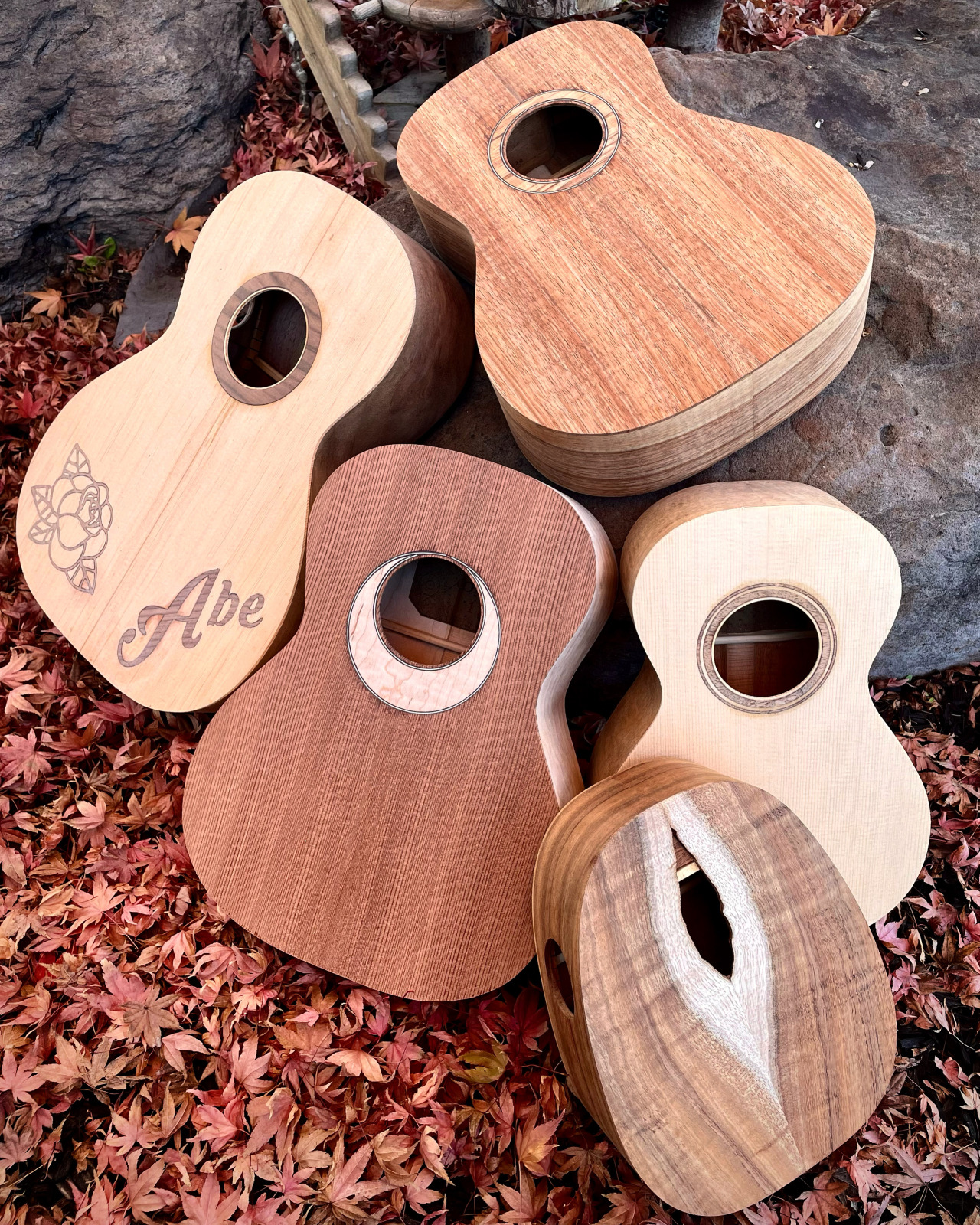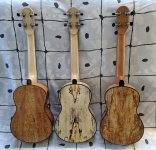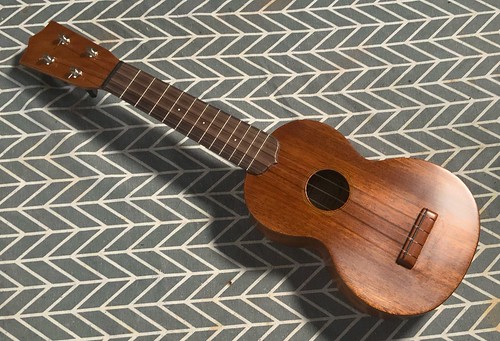You are using an out of date browser. It may not display this or other websites correctly.
You should upgrade or use an alternative browser.
You should upgrade or use an alternative browser.
What's happening in your shed?
- Thread starter BR Ukuleles
- Start date
looks amazing! thanks for the string tip. i’ll pick up a set and give them a try when i finish up the build next month.D'Addario EJ87S Titanium Ukulele Strings, Soprano
They will work with shorter scales using the D tuning (ADF#B) and with GCEA.
View attachment 137157
Just closed up these 5 and getting ready for binding.


Jim Hanks
Well-known member
You missed a spotJust closed up these 5 and getting ready for binding.
jupiteruke
Well-known member
The latest set of three. They are all commissions, and while they are all tenors, they are all rather different from one another and a bit unique, from the subtle to the full Nashville. From left to right:
Aromatic cedar top, caramel sycamore back & sides, rosette in green recon stone, casuarina fingerboard & bridge, curly koa binding, bookmatched sycamore headplate.
Port Orford cedar top, spalted tamarind back & sides, Kasha bracing, ebony fingerboard, bridge & headplate, black bog oak binding, pink abalone rosette, sea turtle inlay, 'piper' fingerboard inlay.
Pennsylvania red cedar top, spalted mango back & sides, Brazillian ebony fingerboard & bridge, east indian rosewood binding, paua abalone spiral rosette, stylized Hawaiian turtle 'honu' headplate inlay.





Aromatic cedar top, caramel sycamore back & sides, rosette in green recon stone, casuarina fingerboard & bridge, curly koa binding, bookmatched sycamore headplate.
Port Orford cedar top, spalted tamarind back & sides, Kasha bracing, ebony fingerboard, bridge & headplate, black bog oak binding, pink abalone rosette, sea turtle inlay, 'piper' fingerboard inlay.
Pennsylvania red cedar top, spalted mango back & sides, Brazillian ebony fingerboard & bridge, east indian rosewood binding, paua abalone spiral rosette, stylized Hawaiian turtle 'honu' headplate inlay.





Heck of a nice trio of ukes. What is the lighter colored neck woods?The latest set of three. They are all commissions, and while they are all tenors, they are all rather different from one another and a bit unique, from the subtle to the full Nashville. From left to right:
Aromatic cedar top, caramel sycamore back & sides, rosette in green recon stone, casuarina fingerboard & bridge, curly koa binding, bookmatched sycamore headplate.
Port Orford cedar top, spalted tamarind back & sides, Kasha bracing, ebony fingerboard, bridge & headplate, black bog oak binding, pink abalone rosette, sea turtle inlay, 'piper' fingerboard inlay.
Pennsylvania red cedar top, spalted mango back & sides, Brazillian ebony fingerboard & bridge, east indian rosewood binding, paua abalone spiral rosette, stylized Hawaiian turtle 'honu' headplate inlay.
sequoia
Well-known member
Nice... Does the Kasha braced uke sound noticeably different from the other two and how does it stand up?
jupiteruke
Well-known member
The lighter wood is Pennsylvania poplar (aka tulip poplar) Liriodendron tulipifera. I started using it when I went looking for more local woods and found that the stiffness/weight ration of poplar was very good. Makes a nice balanced instrument, weight wise, and I can get/cut perfectly quarter-sawn chunks.Heck of a nice trio of ukes. What is the lighter colored neck woods?
jupiteruke
Well-known member
The Kasha bracing yields a bit more on the low end sound, but the difference is not dramatic, at least compared to my normal modified X bracing. I did some more direct comparisons and wrote it up on my blog, http://jupiteruke.com/blog/, "The Three Tenors" down toward the bottom of the page.Nice... Does the Kasha braced uke sound noticeably different from the other two and how does it stand up?
By how does it 'stand up' I assume you mean top-deflection wise. I have built a number of Kasha braced instruments and have never seen or heard of any problem with bridge rotation etc.
I had a feeling that was tulip poplar. I have for some time thought it would be suitable for uke necks and I guess you've confirmed that for me. Around here we just call it "poplar" or "yellow poplar".The lighter wood is Pennsylvania poplar (aka tulip poplar) Liriodendron tulipifera. I started using it when I went looking for more local woods and found that the stiffness/weight ration of poplar was very good. Makes a nice balanced instrument, weight wise, and I can get/cut perfectly quarter-sawn chunks.
I've got some colorful quartered poplar boards that I may turn into uke bodies but I worry they might turn out "dull" sounding.
sequoia
Well-known member
When I wrote "stand up" that meant how does it compare to the fan braced instruments.The Kasha bracing yields a bit more on the low end sound, but the difference is not dramatic, at least compared to my normal modified X bracing. I did some more direct comparisons and wrote it up on my blog, http://jupiteruke.com/blog/, "The Three Tenors" down toward the bottom of the page.
By how does it 'stand up' I assume you mean top-deflection wise. I have built a number of Kasha braced instruments and have never seen or heard of any problem with bridge rotation etc.
jupiteruke
Well-known member
A while ago, when I made fan braced instruments, the Kasha sounded noticeably better. Now I am using what I call a modified X brace, with some Kasha principals involved, and the difference between Kasha and my X braced is rather slight.When I wrote "stand up" that meant how does it compare to the fan braced instruments.
Timbuck
Well-known member
Gluing on the bridge...while organising the evenings entertainment.
 DF9328-43DA-43F8-A930-F4F27AE0758A by Ken Timms,
DF9328-43DA-43F8-A930-F4F27AE0758A by Ken Timms,
Now ready for auction.
 75745AB4-3986-4859-93E1-F85465C04675 by Ken Timms,
75745AB4-3986-4859-93E1-F85465C04675 by Ken Timms,
 DF9328-43DA-43F8-A930-F4F27AE0758A by Ken Timms,
DF9328-43DA-43F8-A930-F4F27AE0758A by Ken Timms,Now ready for auction.
 75745AB4-3986-4859-93E1-F85465C04675 by Ken Timms,
75745AB4-3986-4859-93E1-F85465C04675 by Ken Timms,Titchtheclown
Well-known member
This Lemmy tribute bass uke is based on Rickenbacker's Lemmy signature design. Wood species include: Spotted gum fretboard, Tasmanian oak through body neck and rear body stripe; meranti body sides and back; Tasmanian blackwood volume and tone knobs.
Carving was done by marking out with X-acto style knife, removing spaces between the oak leaves with a usb rechargeable rotary tool, chisels and gouges. Leaves were shaped more with knives, chisels and gouges. The rotary tool was used to texture areas, especially between the leaves. A dark oak stain was used between the leaves for contrast. Star shaped fret markers cut from abalone shell kitchen leftovers. Strings are Aquila thunderguts. Binding is white ABS. Generic tuning pegs, under saddle piezo pickup and preamp off Aliexpress or Ebay.

Carving was done by marking out with X-acto style knife, removing spaces between the oak leaves with a usb rechargeable rotary tool, chisels and gouges. Leaves were shaped more with knives, chisels and gouges. The rotary tool was used to texture areas, especially between the leaves. A dark oak stain was used between the leaves for contrast. Star shaped fret markers cut from abalone shell kitchen leftovers. Strings are Aquila thunderguts. Binding is white ABS. Generic tuning pegs, under saddle piezo pickup and preamp off Aliexpress or Ebay.

- Joined
- Nov 22, 2017
- Messages
- 413
- Reaction score
- 774
I am always worried about the center seam opening up, so the single brace acts as both a cleat on the seam, and resistance against bridge...if that makes sense. On a one-piece top, many builders skip the bracing altogether.Hey Tukanu, I see you have the single "fan" brace down the center. I recently did that on a thin RWC soprano as well, and it's by far the best sounding uke I've ever made.
Similar threads
- Replies
- 3
- Views
- 330
- Locked
- Replies
- 1
- Views
- 592
- Replies
- 4
- Views
- 617








